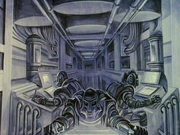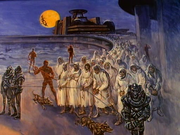No edit summary |
|||
| Line 5: | Line 5: | ||
== Thinking Machines’ Empire == |
== Thinking Machines’ Empire == |
||
| − | Having been first created by the [[Old Empire]] to do everyday tasks for humans, the thinking machines rose up during the [[Time of Titans]] and took control of many inhabited worlds. |
+ | Having been first created by the [[Old Empire]] in 5,360 B.G/6,041 A.D to do everyday tasks for humans, the thinking machines rose up during the [[Time of Titans]] and took control of many inhabited worlds. |
Led by [[Omnius]], a powerful computer [[Artificial Intelligence|AI]] that was also known as the Evermind, they quickly established an intergalactic empire that engaged in a protracted war of attrition with the remaining free humans, who called themselves the [[League of Nobles]]. The later stages of the war saw an escalation in tensions that were dubbed the ''[[Butlerian Jihad]]''. The Jihad ended with the defeat of the thinking machines at the hands of the free humans during the [[Battle of Corrin]]. |
Led by [[Omnius]], a powerful computer [[Artificial Intelligence|AI]] that was also known as the Evermind, they quickly established an intergalactic empire that engaged in a protracted war of attrition with the remaining free humans, who called themselves the [[League of Nobles]]. The later stages of the war saw an escalation in tensions that were dubbed the ''[[Butlerian Jihad]]''. The Jihad ended with the defeat of the thinking machines at the hands of the free humans during the [[Battle of Corrin]]. |
||
Revision as of 08:07, 26 May 2009

Thinking Machines as shown in the prologue of Dune (1984 movie)
The term Thinking Machines referred to both an actual beings and a general concept, both of which had a profound impact on the development of humanity over the span of many millennia.
Thinking Machines’ Empire
Having been first created by the Old Empire in 5,360 B.G/6,041 A.D to do everyday tasks for humans, the thinking machines rose up during the Time of Titans and took control of many inhabited worlds.
Led by Omnius, a powerful computer AI that was also known as the Evermind, they quickly established an intergalactic empire that engaged in a protracted war of attrition with the remaining free humans, who called themselves the League of Nobles. The later stages of the war saw an escalation in tensions that were dubbed the Butlerian Jihad. The Jihad ended with the defeat of the thinking machines at the hands of the free humans during the Battle of Corrin.

Humans enslaved by the Machines, as shown in the prologue of Dune (1984 movie)
During the time of the Butlerian Jihad Omnius controlled most thinking machines with a few exceptions. The most notable of these were Erasmus, who killed Serena Butler's infant son while she was his slave; and Chirok, a reprogrammed combat robot used by Ginaz for training of League forces.
Conceptual Thinking Machines
Following the rise of the actual thinking machines, and the physical and psychological damage they inflicted on the free humans, the very concept of a sentient machine became abhorrent to humanity.
Animosity against seemingly intelligent machines often escalated into outright hysteria, and resulted in a widespread hatred of mechanical objects. This hatred lasted through the ages thanks to rigid cultural restrictions, a good example of which was the Orange Catholic Bible's supreme commandment: Thou shalt not make a machine in the likeness of a human mind.
Unity with Man-Kind
Although Thinking Machines continued to be mankind's greatest enemy in the span of over fifteen thousand years, they eventually did achieve an understanding and a type of unity with the rise of the Ultimate Kwisatz Haderach, Duncan Idaho.
Idaho was able to merge with and accept the Evermind controls from the Independent Robot Erasmus before Erasmus died, which enabled him to direct the entire Thinking Machine Empire during the time of the Kralizec, and for hundreds of years afterwards.
